Fruit butter is one of the best ways to preserve the harvest. Just as with other fruit like crabapples, you can take a puree of wild plums and bake it or use a slow cooker to make homemade wild plum butter. Here's how to do it from start to finish, from any kind of plum.
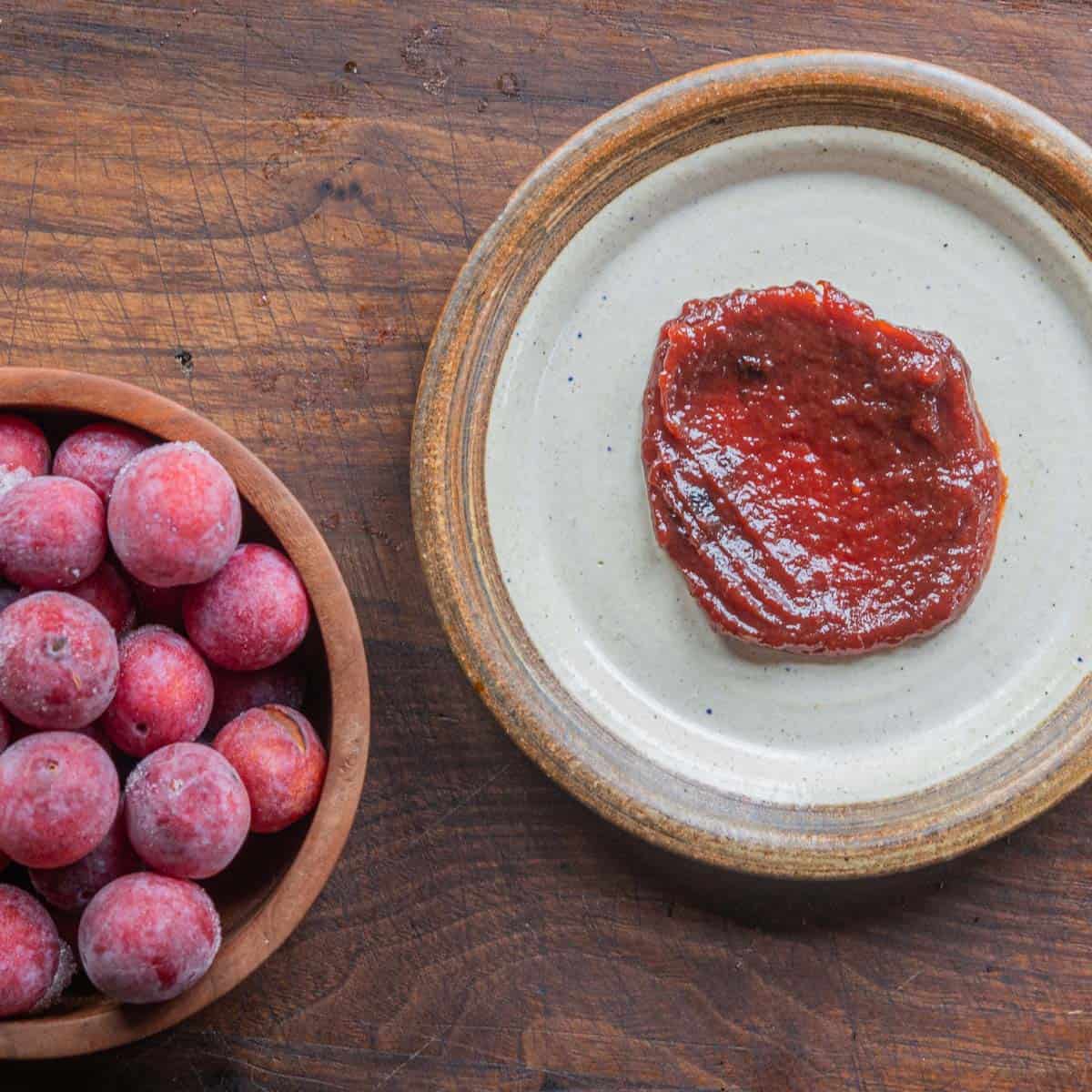
Chef's Note
This post was originally a recipe for candied wild plums in syrup. It worked very well with some varieties of plums, but the variation between individual American wild plum trees made the results inconsistent. This simple wild plum butter is here to take its place. It's dependable, easy to make, and is ready in a fraction of the time of the previous recipe.
Wild Plum Types
First you'll need to harvest ripe wild plums. This wild plum butter recipe is made specifically for wild plums with tough, astringent skins like American wild plums (Prunus americana) and Canadian wild plums (Prunus nigra). But, any wild plum, like beech plums (Prunus maritima) and sand plums (Prunus angustifolia) will work too.
You can also use other plum varieties like purple skinned Damson or Italian plums which are sweeter and not as tart as most American wild plums. Cultivated plums can be pureed, skin and all without becoming astringent like many wild plums.
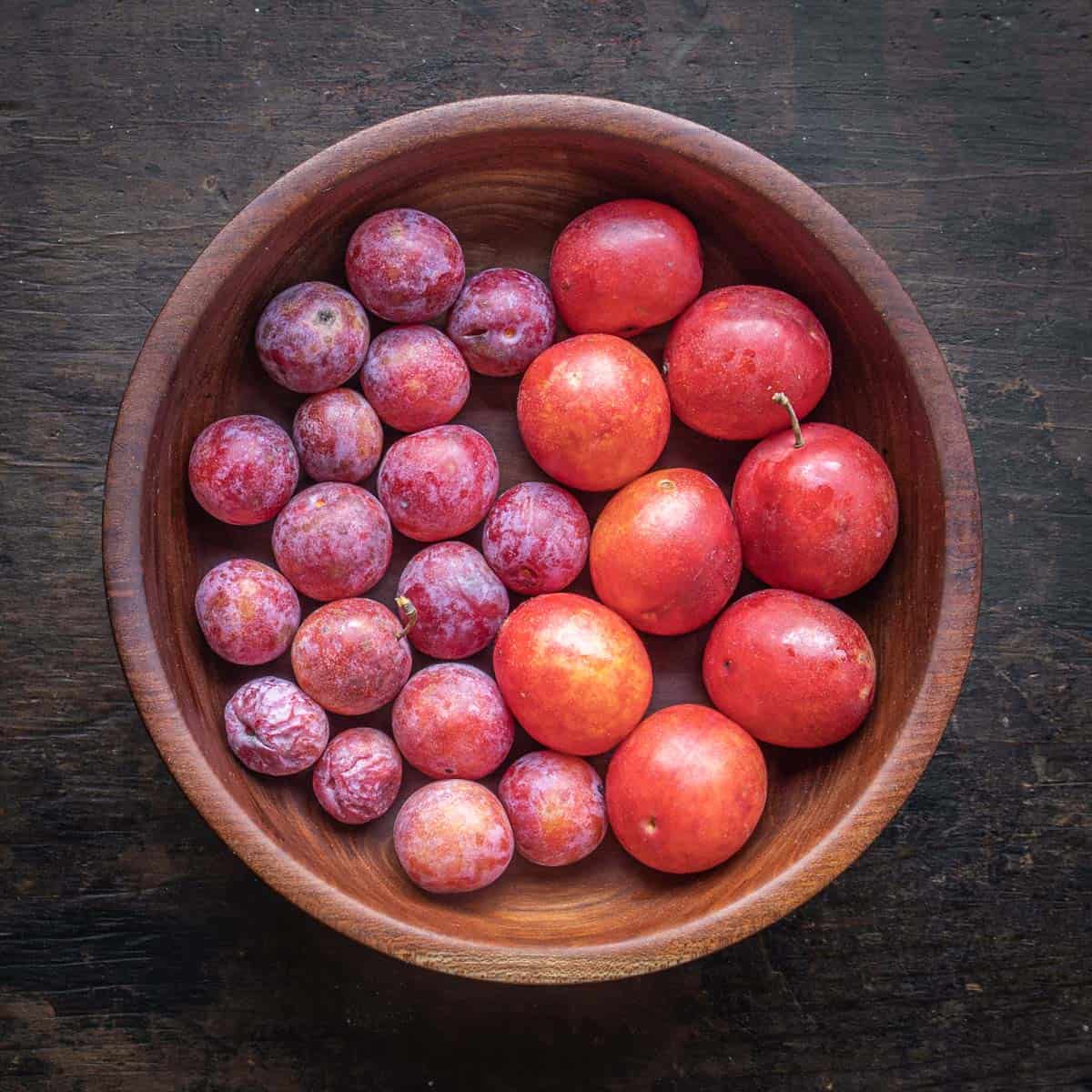
Wild plums can ripen unevenly on the tree. If this sounds like your plums, a good trick to remember is that you can hold the plums in a brown paper bag to get them to the perfect stage of ripeness. Ripe plums will be much easier to work with than unripe plums.
How to Make Wild Plum Butter
First you'll need to make a puree of wild plums. There's a few ways that you can do this. One of the easiest is to freeze the wild plums. Freezing the plums allows you to process them during the off-season, since fruit harvesting season is generally a busy time for foragers.
If the plums are fresh, you can warm them gently in an oven, or remove the pits individually and then rub them through a screen or a colander as I demonstrate in the video. As wild plums are much smaller than other types of plums, removing the pit from each one takes a lot of time, and is not my first choice.
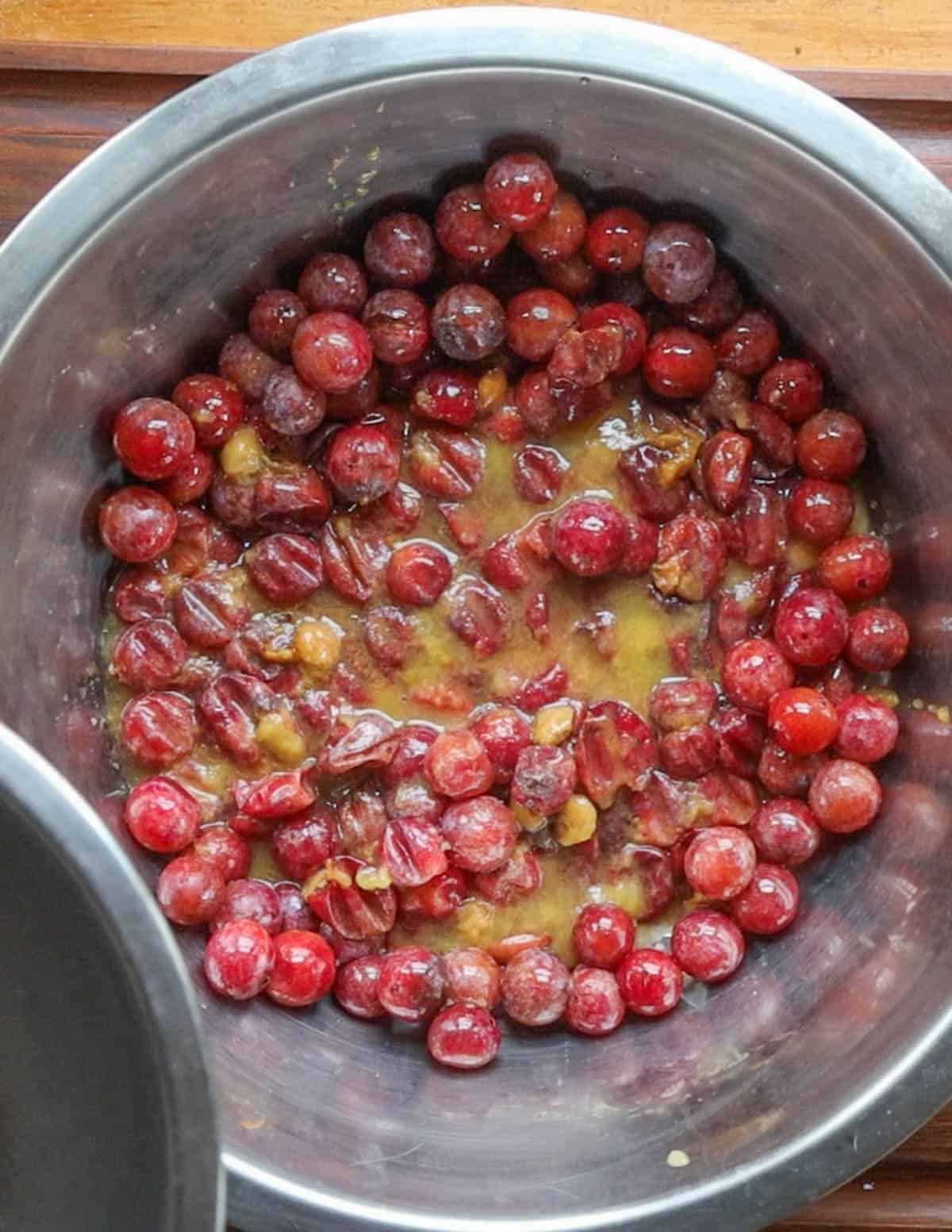

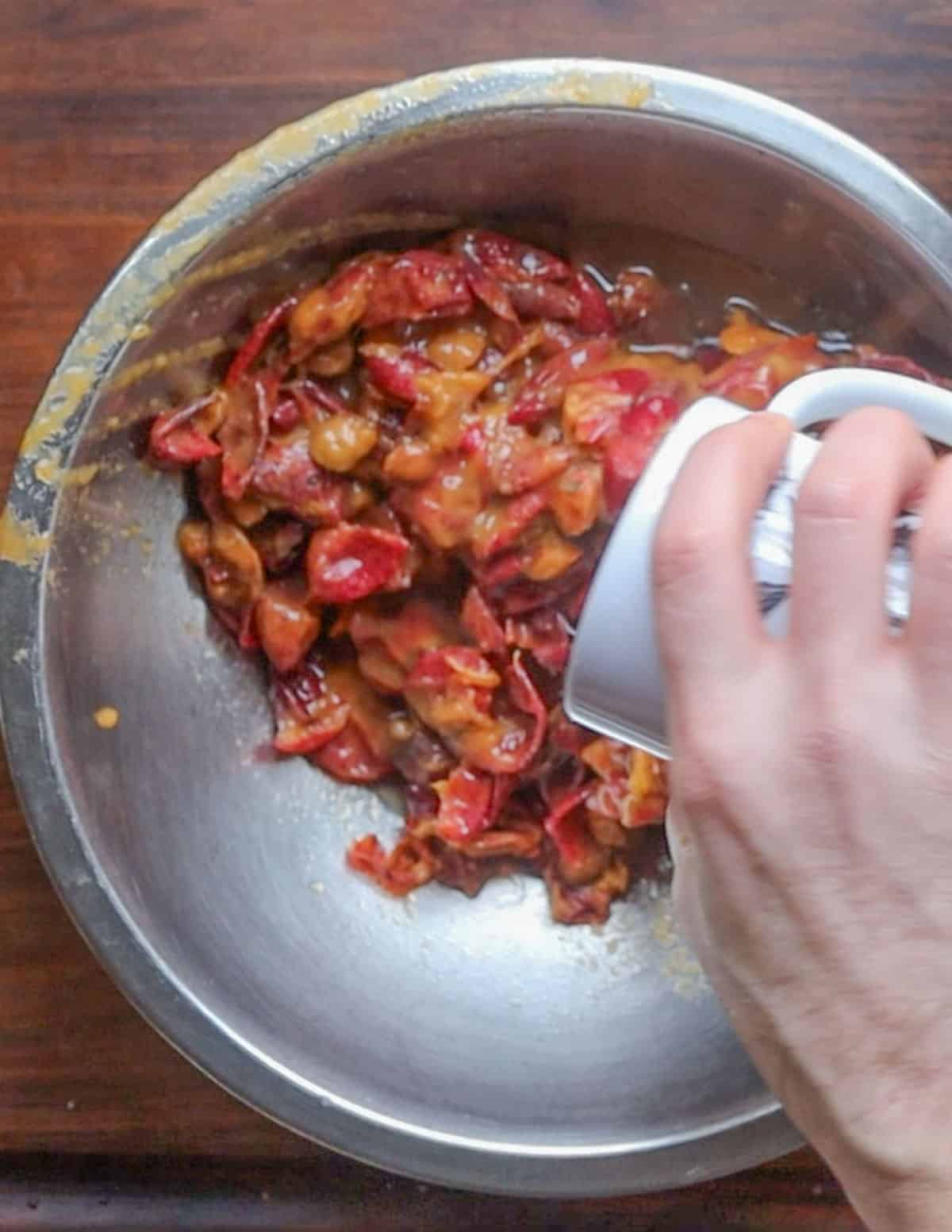
Once you've made your puree of wild plums, all you need to do is add a little maple syrup, regular or wild wild vanilla extract, cinnamon and a pinch of salt. Many recipes simply call for white sugar, but maple syrup or raw turbinado sugar will give a superior flavor.
Once the plum puree is mixed up, it's put into a pot and baked in the oven to evaporate water and concentrate it. It's the same technique I use to make crab apple butter.
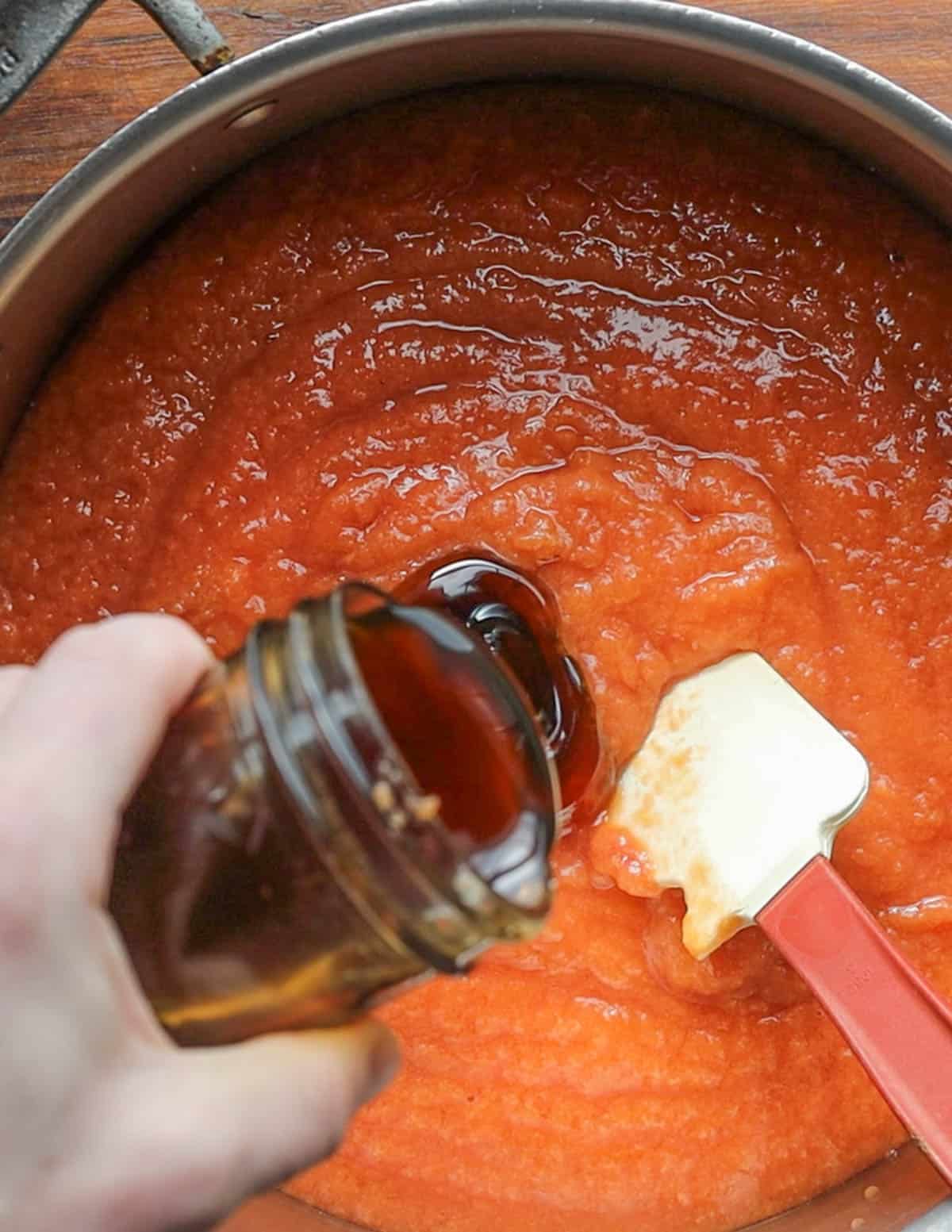
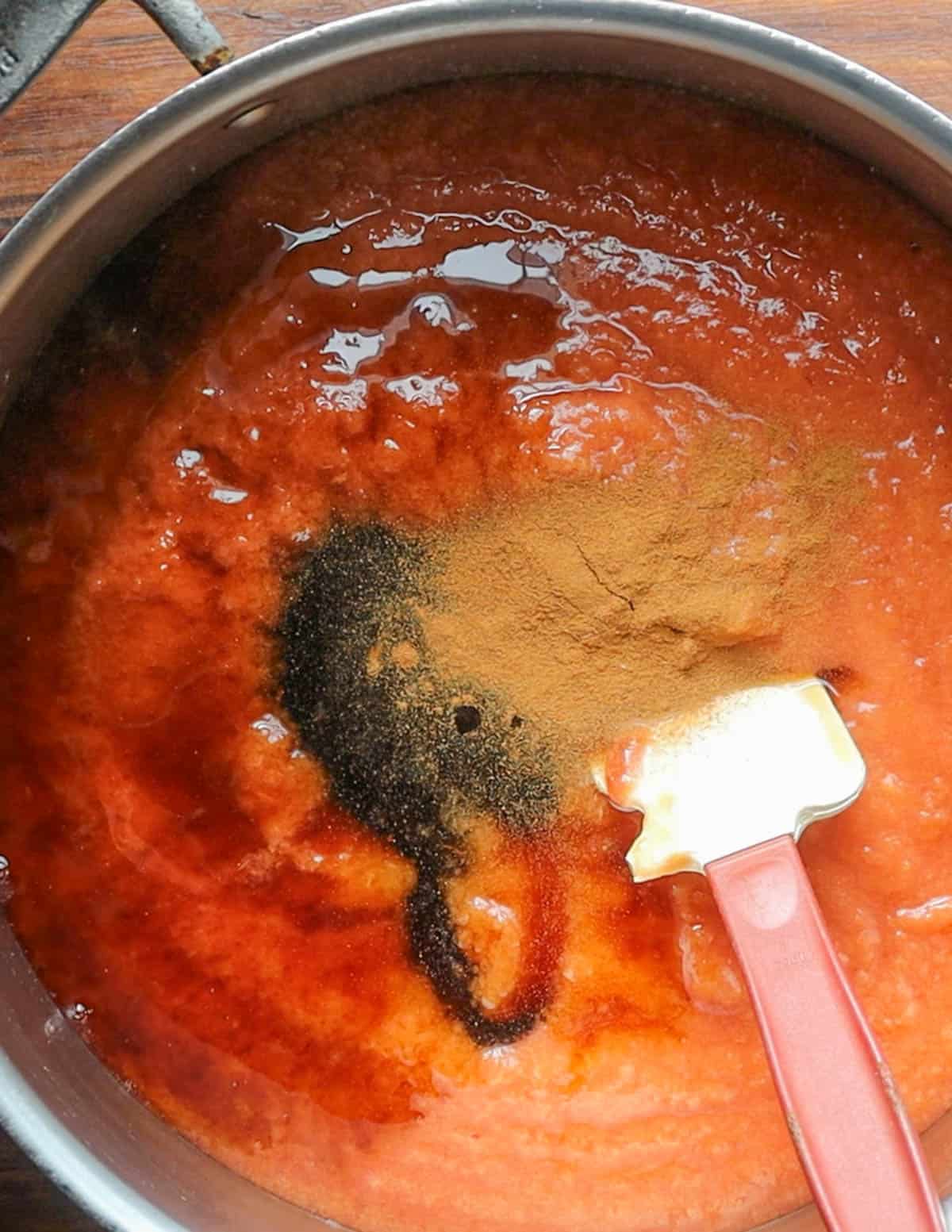
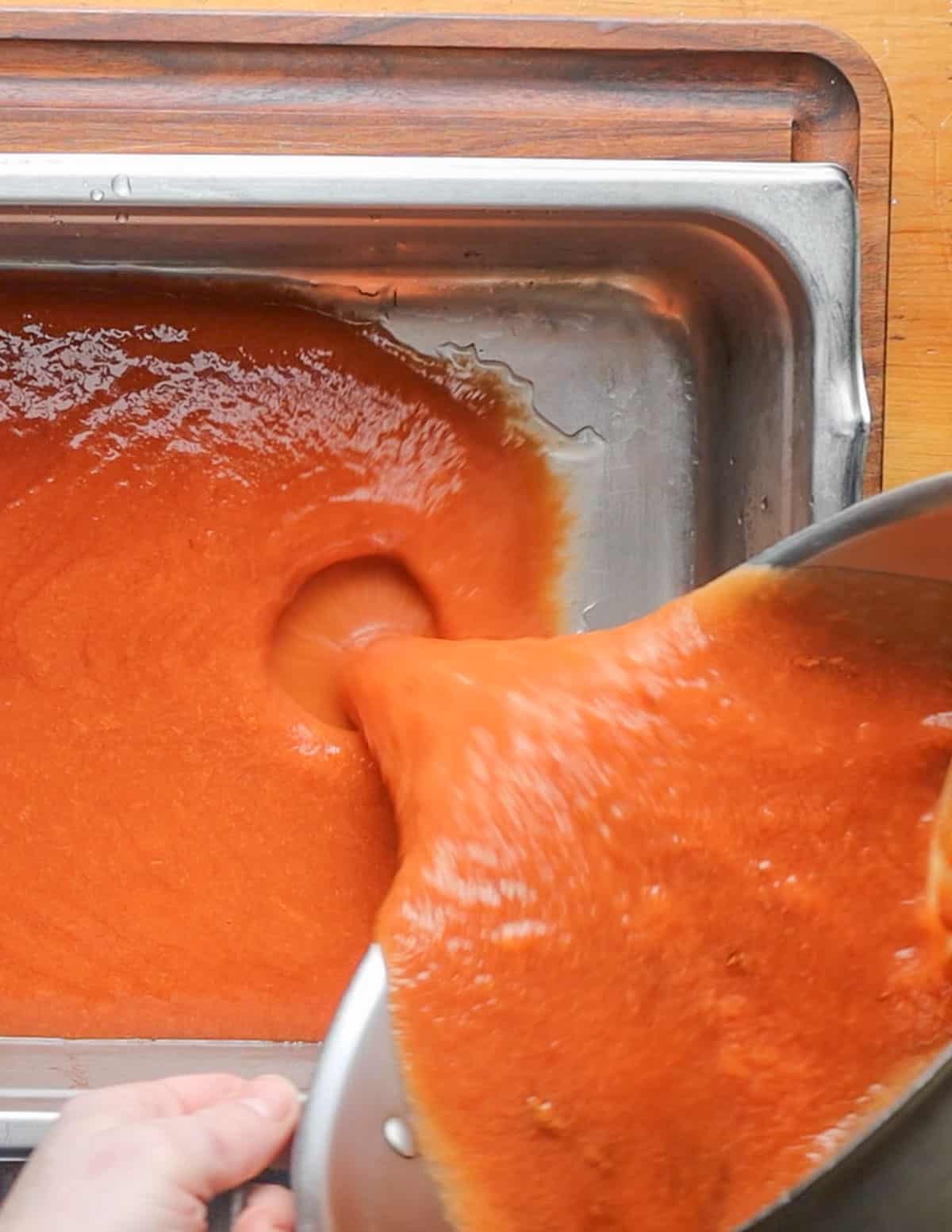
While the plum butter is baking, make sure to check on it at least once an hour, whisking occasionally to make sure none of it is sticking to the bottom of the pan.
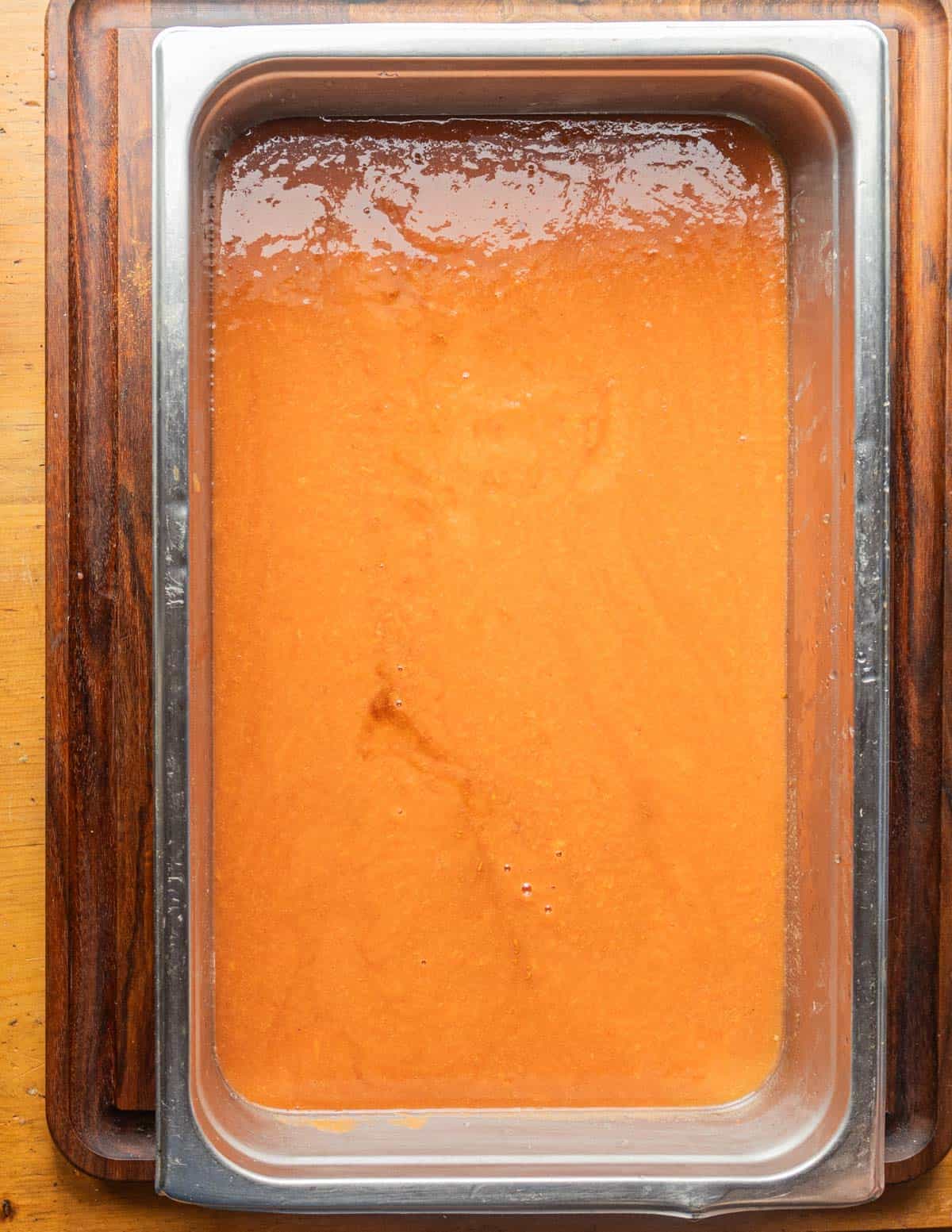
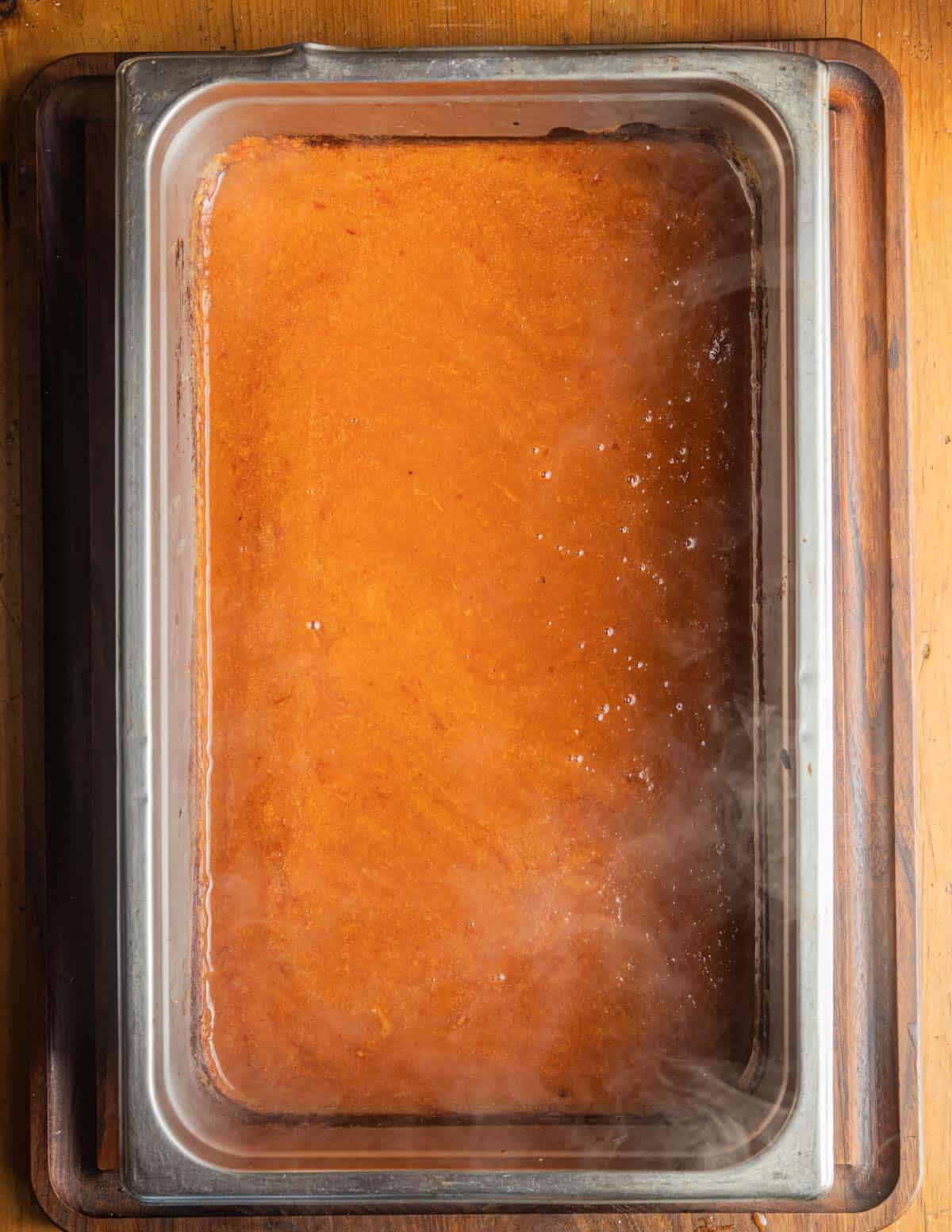
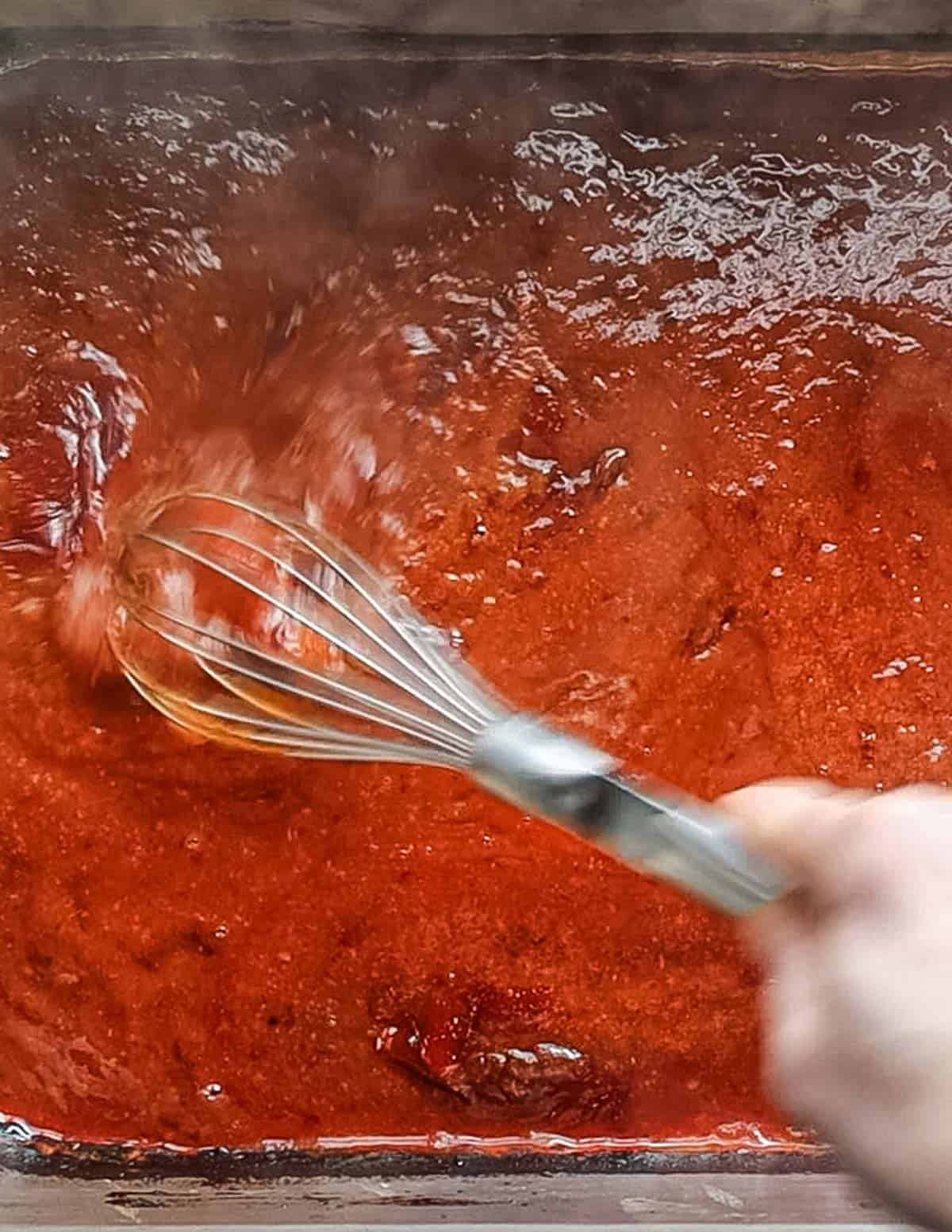
After a few hours, the plum butter will thicken as the water evaporates. once you can see the bottom of the pan after pushing a spatula through it, it's done.
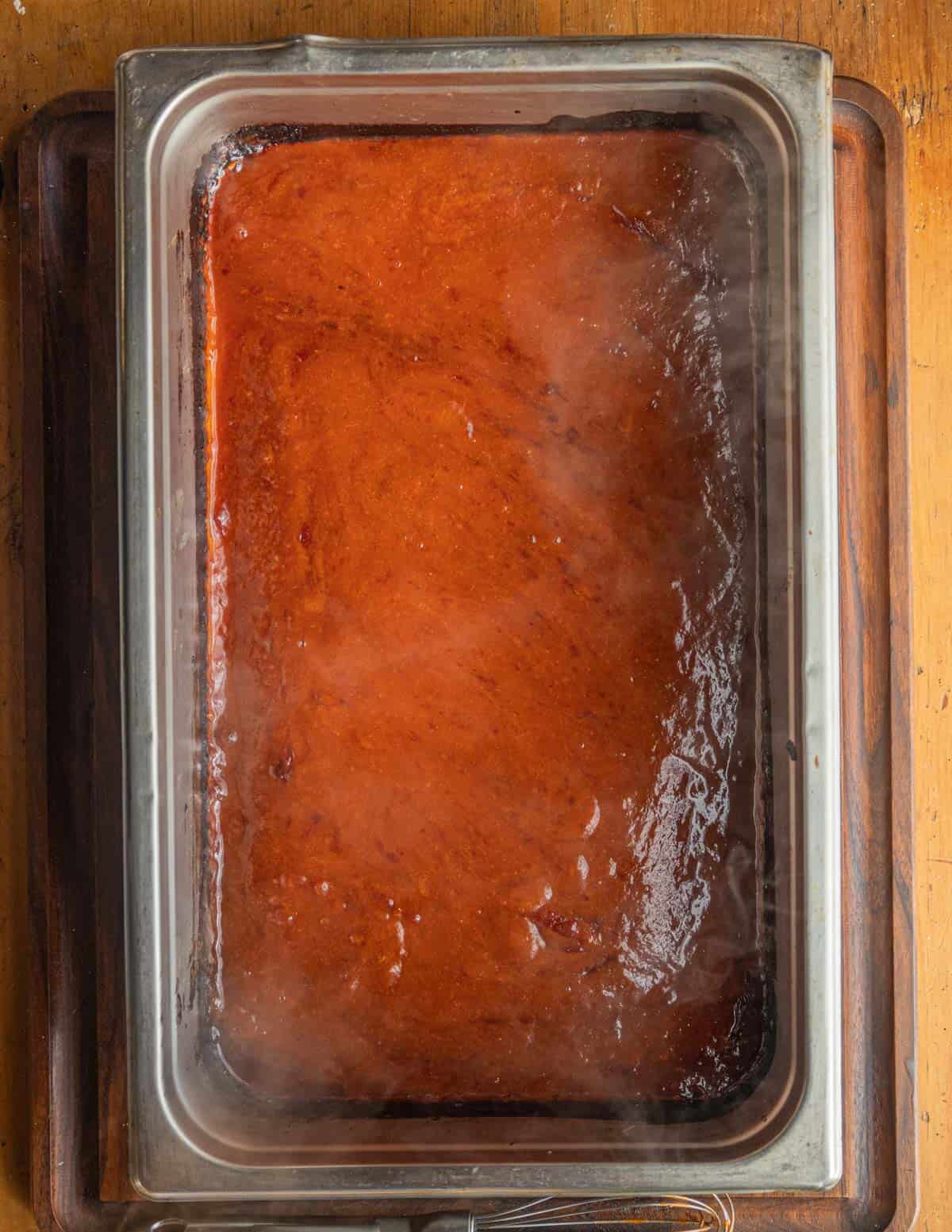

The finished wild plum butter can be put into mason jars and canned in a water bath, held in the fridge for a few weeks, or frozen for long term storage.

More Wild Plum Recipes
Maple Wild Plum Butter
Equipment
- Mason jars, water bath canner (optional)
- 1 large mixing bowl
- 1 Soup pot or pasta pot
- 1 very wide pot or baking dish I use a restaurant hotel pan that's 12 x 20 inches. Use multiple pans if you need.
Ingredients
Plum Puree
- 1 gallon Wild plum puree made from 10-15 lbs of wild plums.
- 2 cups Maple syrup or brown sugar
- 1 teaspoon Cinnamon
- ¼ teaspoon Kosher salt
- 2 teaspoons Lemon juice from concentrate
- 1 teaspoon vanilla extract or wild vanilla extract, or ½ a vanilla bean
Instructions
Wild Plum Puree
- First make the plum puree. If you have fresh plums you can stone them, mash them up by hand, then rub them through a screen or a colander.
- If you have whole, frozen wild plums, you can mash them by hand and pass them though a colander into a larger bowl.
- When you're done, add a cup or two of water to the plum skins and pits. Mix the water around to loosen the extra puree, then rub it through the screen or colander again.
Bake the Plum Butter
- Preheat the oven to 325 F.
- Mix the plum puree, maple syrup, vanilla and cinnamon in a bowl or large pot.
- If you want a very smooth butter, you can puree the mixture now with an immersion blender.
- Pour the plum puree into a wide baking dish with high sides. Alternately you can use a slow cooker or a deep hotel pan as shown in the post.
- Bake the plum puree until the water has evaporated and it's thick. You should be able to see the bottom of the pan when you drag a spoon or spatula through it.
- The cooking time will vary depending on your equipment, but expect at least 2-3 hours of cooking.
Storing
- If you want to water bath can the plum butter, beat in 2 teaspoons of lemon juice now.
- Transfer the plum puree to pint or half pint mason jars and process in a water bath for 10 minutes. You can also freeze the plum butter.


Angela
Hello again--I realize I posted a question and haven't even given you time to reply yet before submitting another query---this is a learning process! The deer were flocking around the plum trees this morning as I arrived, so I decided to just pick what I could. However, now that I am fully-invested I am unsure what the "fully ripe" stage truly is. I was under the impression that P. Americana was ripe once dark purple, but I think these are only going from green to yellow to peachy to red to brown (over-ripe) and some are half unripe and half dark brown. No purple ones. Do I just toss the darker ones? Also, many have black holes or spots on them----the tree shows signs of fungus on its branches, but I would hate to throw away all those with spots. Are they okay to use?
Alan Bergo
Hey Angela, Prunus americana can be a really frustrating fruit to work with. The best advice I can give you is that, again, the fruit can vary drastically from tree to tree. Dark brown fruit are probably fermented and fizzy so I toss those. Peachy red to deep red, and just barely tender is what I look for. I pick them as I go and toss them in the freezer if I can't get a bunch at once. There is typically a decent amount of waste, meaning that some plums just go bad fast-toss them and save the good ones.
Angela Nowysz
Hi, Alan--Thoroughly enjoying your "delve" into wild plums, and finding it very insightful. I've finally timed my three wild plum trees well here in Iowa, and see they have quite a bit of fruit I would like to extract (if I can foil the wildlife). Just need a clarification on when to pick: right now they are yellow or yellow/pink with only a few turning dark. Is it okay to pick them all for the sake of out--competing the critters, and ripen them as you suggest indoors where it is cool? I would hate to pick them too early and ruin the whole crop. Thanks!
Alan Bergo
Hi Angela. There can be a lot of variation with P. americana from tree to tree. I usually wait until I can shake them from a tree like other fruit. I don't see a lot of competition with wildlife for them where I am.
Melanie
Hi! Boy, I don't know how I ended up with 6 pints of plum butter from my gallon of pulp. I gave up at nearly 2 days of reducing, it turned very dark (like prunes) but I just couldn't get it to reduce to any less than 6 pints. There was absolutely no water added prior to reducing. I don't know my variety of american plum, as it was a gift, but my plums never wrinkle up or have that "dusty" ripe look to them. I think they are hogplums. Smaller than the plums you have shown and are a deep red/purple when ripe. Very tart, almost no sweetness to the point that my husband won't eat it. I ended up adding 3 cups of brown sugar, and extra amounts of spices because we couldn't taste anything but tartness. Anyway, I still like the flavor, but I'm at a loss of what to do with all this plum butter, lol. I went ahead and froze it and hope I can make cakes or muffins from it. I made the jam and it was awesome! Maybe I'll just stick to that.
Alan Bergo
Hi Melanie. That's a lot of time to dedicate to making plum butter, it should only take a few hours. Since you don't know what type of plums you have it's difficult for me to pin point what's going on here. Prunus americana is not very juicy, and other plums definitely are, and you might need to add more sugar to them, as you found out there. Plum butter is still really good and worth making though, and I like it as it doesn't have as much sugar as jams and jellies. 2 days is way too long though, Im wondering if you used a deep pot/vessel for reducing in the oven, which would definitely take a very long time to evaporate liquid compared to a wider pan like I show in the video here. I am using a restaurant 4 inch hotel pan that's 12 inches by 20 inches, the large amount of surface area drastically reduces the time you'll need to bake it in the oven.
Melanie
Oh!!! That was it! Yes, I didn't have a hotel pan and the only thing I had large enough to hold a gallon was a soup pot. I will definitely go an find a hotel pan next time. I still love the end product, but I'll try again with a wider pan. I still have another tree that is ripening now so I think I'll freeze them and find the right pan. Many thanks!!!
James
A little labor intensive but definitely worth it. I think your plum jam is still my favorite wild plum recipe.
Michelle Huber
I made this recipe and WOW! These are so great! One question I have is-my plums look exactly like yours, except that the skins are wrinkled on most of them-do you know why this happened and how I can avoid this next time? The ones that did not wrinkle look so beautiful, just like yours in the photo above!
Alan Bergo
Hi Michelle. I see that happen here and there with them, but never all. I suspect it's from plums that are too firm, but I can't be certain. Did you prick them with the needle?
Mats L
Brilliant!
Just gathered several kilos of yellow wild plums, and I want to make something nice out of them, but, how do you remove the pits, or “seed”, without breaking their beautiful form?!
Do you just do halves out of the entire batch? Or cook them with the pits remaining inside? Will the pit somehow become edible if prepared in this manner?
Thanks for writing this well thought-out recipe. 🙇🏼♂️
Kind regards, Mats
Alan Bergo
You don't remove the seeds. It's like the pit of an olive-they taste better with it in-more meaty and they hold their shape. Also, you need to make sure you know what type of plum you're cooking. I cook exclusively with Prunus americana and they should not be cooked in their yellow stage. They must be very ripe.
Susan
I can’t see info here about how long to cook in the water bath canning process. Am in Wisconsin. Other recipes mention 20 minutes for canning pint jars. Your thoughts? Thank you for the great recipe
Alan Bergo
I don't process this in a water bath-it's a hot pack. Technically the powers that be would pooh-pooh hot packing but as this recipe includes not only sugar, but vinegar, and beyond that, a multi-step saturation process, it is completely safe to simply put in the jars piping hot, screw on the lids tight, turn upside down, and allow to seal. You can process them for 10-15 minutes if you like though-totally up to you. I've adjusted the recipe copy to reflect it, too. Thanks.
Hannah
Going to make these today or tomorrow. When do you take the spice sachet out?
Alan Bergo
Before you can them. A minute detail.
Becky
If canning do you really need to soak overnight twice? Or can I just make the syrup and hot pack and can them? Is there a reason for the overnight soak as far as preserving or is it more a flavor thing?
Alan Bergo
You can just hot pack them and they'll be fine. I'm actually doing a batch like that this week. The soaking is to help the sugar penetrate the flesh of the plums, it transforms the flesh and candies it. It's a very special texture.
SC
Hi Alan! Thank you for sharing this recipe. I made it and was over the moon by how delicious and fine-textured the plums were by the time I put them in their jars. But something seems to have happened since I canned them— I just opened a jar and the plums are now a bit wrinkly, and stuck together, and the skin is much tougher than it was the day I canned them. Do you have any thoughts about what I might have done or what I might do different next time? The flavor remains wonderful, but I’m sad the skin texture has changed! Thanks for any thoughts or guidance.
Alan Bergo
Hmm.Did you water bath process them after you did the candying process?
SC
Hi Alan— thank you for writing. No, I didn’t water bath can them, just open kettle (for personal and quick consumption). I wasn’t sure if I may have heated them too much in the syrup— would that have caused the skins to seize? I am pretty sure it happened after they had been in jars a few days, though. The second batch I made doesn’t seem to have had this problem, the only thing I think that I may have done differently is during the last step of the second batch I think I strained the syrup first, brought that to a boil, added plums, returned to a boil, and then pulled them out into jars. I think for the first round, I heated them in the syrup. I just wasn’t sure if you had thoughts on what might toughen the skin after it was so lush— a true puzzle for me! The second batch might have been with riper plums, too... a mystery! But they are so delicious, thank you for sharing the recipe.
Alan Bergo
SC. So wild plums vary widely from tree to tree. I have access to some managed stands of them that produce evenly ripe plums consistently, but many truly feral ones will have some uneven ripening. Re: tough skins, from my experience that can happen a bit with slightly underripe plums, which can be hard to pick out sometimes, especially when they look and smell good. I may have to put a note in here about picking out only the ripest plums.
Deana Martz
I have just canned six half-pint jars of these plums and had a few left over for tasting. Wow! The plums are beyond amazing. I have tried over and over to can plums with disappointing results but now I have plums to serve proudly throughout the long Manitoba winter. As I drove home yesterday, I spied what I thought was a wild plum shrub full of fruit on the edge of a field. I braked and backed up to check it out. Sure enough it was a plum full of golf-ball sized fruits and it was in the road allowance so I wouldn't be trespassing if I picked them.. However, the shrub was surrounded by calf-high poison ivy so I thought, no, I don't need more plums that much. However, now that I have tasted these candied plums, I must make more! So tomorrow I am going prepared for poison ivy and will pick them if the wind hasn't dislodged them. Thank you for persevering with the recipe and sharing it.
Alan Bergo
Deana, I'm so glad you like them! They're a special preserve, and probably not for everyone, but once you get used to the stones being in them, they're excellent.
Therese Sexe
hi alan,
i was comparing your recipe for candied plums to amy thielen's. hers calls for considerably less vinegar. because you referenced her, i was just checking to see that the vinegar you call for is correct amount. thanks for your help.
Alan Bergo
This is the correct amount. Water and vinegar in equal or nearly equal parts is a nice foil for the amount of sugar IMO.
Therese Sexe
thanks for the reply, alan. i'm on the 3rd day and so far so good.
Barbara Freeman
can you use these plums to make sweet and sour sauce
Alan Bergo
Yes, just extract the pulp and discard the skin.
Carla Beaudet
This is exciting; over the summer I harvested and made plum sauce from some wild plums growing along our driveway that looked too nice to pass on, but the sugar didn't remove the astringency, even though I left the skins and pits behind in a sieve. Here, it sounds like you're succeeding even with the skins left on! I also note that your ripeness criteria (at least color-wise, between this and previous posts) has shifted from the redder end of the spectrum towards the yellower. That would make harvesting easier, since (as you noted previously) the window of opportunity between a little red and starting to go soft is very brief. Tasting the raw plums last summer, I noted that the riper ones were sweeter, but it didn't really remove their inherit astringency. Sweet doesn't mitigate astringency as it does sourness. But I'm willing to believe that maybe the acidity of the vinegar will do the trick? I had written these plums off as "not worth it", but I'm happy to give this technique a whirl before I resign myself to giving up on Prunus americana.
Alan Bergo
Hey Carla. If you're referring to my minimalist plum sauce on this site (which should be a little sour and tart--I use it as a garnish to meat) don't give up on it. I worked with more P. americana this year than ever, and I feel like I really cracked the code on the tannins. The problem with them is that the tannins are very water soluble--so anytime we boil them, even if we pass them through the colander to remove skins and seeds, you still get tannin-soaked pulp.
I found either getting very ripe plums (you can freeze them to soften) and passing them through a squeez-o works, or getting ripe to semi-ripe plums, and then baking them to loosen the pulp, means there isn't any place for the tannins to transfer to, and they stay in the skin. Viola. My publisher doesn't want me to share too much info from my upcoming book, but, since I already have a couple plum recipes on here that could benefit from the method, I thought it would be helpful to share. Do try it next year. I'm going to have to go through and see where I can update that method in the site. They're such a bountiful fruit, it would be a shame to give up on them.
Re: ripeness, you have a little wiggle room here, but trying to candy plums that are too under-ripe will result in dried out plums that are tough. Plums that are too ripe may wind up a little softer, but are better than the alternative. When in doubt I'd try to use the ripest ones you can find, and the preliminary pouring over of boiling syrup is designed to be gentle on them here, as simmering them first was a little aggressive, and caused some of my very ripe ones to dissolve over time, leaving nothing but skin.
Carla Beaudet
So, now I'm totally confused. I get it that tannins are water soluble, and yes, simmering the plums extracts the tannins from the skins into the pulp where we don't want them. (Despite my whining about it, that sauce is good enough that I canned most of it, and following your recommendation, I use it with fatty meats like duck or pork chops where the astringency teams up with the sour note to cut the unctuousness.) But unless you were doing something like blanching them and then discarding the water (which is how the bitter is removed from the pith when candying orange peels), I can't understand how the astringency is mitigated in this method as nothing is discarded???
Alan Bergo
The skins are discarded--that's where the tannins are. The leftover mash makes good vinegar.
Carla Beaudet
Triple-confused now. By "this method" in "I can’t understand how the astringency is mitigated in this method as nothing is discarded???" I mean the current recipe. The skins are still on the plums when you can them, AND when you serve them, right?
Alan Bergo
The vinegar and sugar work well, and as they sit for a bit, they mellow out. They become candied. Very ripe plums will have the softest skin, but slightly less ripe ones will still be tolerable. Make a batch and you'll see . True, it doesn't seem to make sense, but if you make some with nice ripe plums, you'll see. Come summer time, let me know if I can help you trouble shoot any of this.
Carla Beaudet
Thanks, Alan; I will give it a shot the next time those loaded trees taunt me, and I'll report back here.